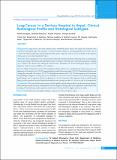Please use this identifier to cite or link to this item:
https://hdl.handle.net/20.500.14356/1347Full metadata record
| DC Field | Value | Language |
|---|---|---|
| dc.contributor.author | Dhungana, Ashesh | - |
| dc.contributor.author | Bhattarai, Devendra | - |
| dc.contributor.author | Shrestha, Prajowl | - |
| dc.contributor.author | Acharya, Niranjan | - |
| dc.date.accessioned | 2023-05-08T07:43:07Z | - |
| dc.date.available | 2023-05-08T07:43:07Z | - |
| dc.date.issued | 2019 | - |
| dc.identifier.citation | DhunganaA., BhattaraiD., ShresthaP., & AcharyaN. (2020). Lung Cancer in a Tertiary Hospital in Nepal: Clinical-Radiological Profile and Histological Subtypes. Journal of Nepal Health Research Council, 17(4), 463-467. https://doi.org/10.33314/jnhrc.v17i4.2078 | en_US |
| dc.identifier.issn | Print ISSN: 1727-5482; Online ISSN: 1999-6217 | - |
| dc.identifier.uri | http://103.69.126.140:8080/handle/20.500.14356/1347 | - |
| dc.description | Original Article | en_US |
| dc.description.abstract | Abstract Background: Lung cancer is the most common cancer worldwide and in Nepal. Non small cell carcinoma is the commoner histological type. The incidence of adenocarcinoma subtype is increasing globally. This study aims to evaluate the clinical-radiological and histological profile and the diagnostic yield of various modalities in the diagnosis of lung cancer at a tertiary hospital in Nepal. Methods: This is a prospective cross-sectional study conducted at National Academy of Medical Sciences, Kathmandu. Patients presenting with clinical and radiological features consistent with lung cancer and undergoing tissue sampling were included. The clinical and radiological characteristics, distribution of various histological subtypes and the diagnostic yield of various modalities were evaluated. Results: Of the 253 patients screened, 77 meeting the inclusion criteria were enrolled into the study. Lung cancer was diagnosed in 53 patients. Forty (75.5%) patients had non small cell carcinoma and 13 (24.5%) had small cell carcinoma. Among the non small cell variants, 20 (37.7%) had adenocarcinoma and 19 (35.9%) had squamous cell carcinoma. Hitopathological diagnosis of lung cancer was established in 39 of the 42 (92.9%) patients by bronchoscopy. Image guided biopsy and/or aspiration yielded the diagnosis in 13 (24.5%) patients. The diagnostic yields of endobronchial biopsy, needle aspiration, bronchial brush and bronchial wash cytology were 86.5%, 70%, 63% and 34.3%respectively. Conclusions: The result of this study concurs with the global trend of rising incidence of adenocarcinoma subtype. Bronchoscopy remains the most commonly used tool for diagnosis of lung cancer and combination of procedures such as biopsy, bronchial brush, needle aspiration and bronchial wash provided the highest yield in our study. Keywords: Bronchoscopy, Histological subtypes, Lung cancer, Tertiary hospital, Nepal | en_US |
| dc.language.iso | en | en_US |
| dc.publisher | Nepal Health Research Council | en_US |
| dc.relation.ispartofseries | Oct-Dec, 2019;2078 | - |
| dc.subject | Bronchoscopy | en_US |
| dc.subject | Histological subtypes | en_US |
| dc.subject | Lung cancer | en_US |
| dc.subject | Tertiary hospital | en_US |
| dc.subject | Nepal | en_US |
| dc.title | Lung Cancer in a Tertiary Hospital in Nepal: Clinical-Radiological Profile and Histological Subtypes | en_US |
| dc.type | Journal Article | en_US |
| local.journal.category | Original Article | - |
| Appears in Collections: | Vol. 17 No. 4 Issue 45 Oct-Dec 2019 | |
Files in This Item:
| File | Description | Size | Format | |
|---|---|---|---|---|
| 2078-Manuscript-13229-1-10-20200121.pdf | Fulltext Download. | 742.27 kB | Adobe PDF |  View/Open |
Items in DSpace are protected by copyright, with all rights reserved, unless otherwise indicated.
